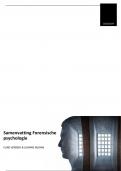2023/2024
Samenvatting Forensische
psychologie
ELINE VERBEEK & LISANNE NIJDAM
Pagina 1 van 67
,Inhoud
Hoorcollege 1 – Introductie Forensische Psychologie............................................................................. 4
Literatuur ........................................................................................................................................... 11
Helfgott, J., & Wallenborn, J. (2021). History of forensic psychology ........................................... 11
Hoorcollege 2.1 – Klinische forensische psychologie ............................................................................ 12
Hoorcollege 2.2 – Patiëntprofielen (TBS profilering) ............................................................................ 17
Literatuur ........................................................................................................................................... 19
Andrews, D.A., Bonta, J., & Wormith, J.S. (2011). The Risk-Need-Responsivity (RNR) model: Does
adding the Good Lives Model contribute to effective crime prevention? .................................... 19
Barnao, M., Ward, T., & Robertson, P. (2016). The goods lives model: A new paradigm for
forensic mental health. ................................................................................................................. 19
Gannon, T. A., Olver, M. E., Mallion, J. S., & James, M. (2019). Does specialized psychological
treatment for offending reduce recidivism? A meta-analysis examining staff and program
variables as predictors of treatment effectiveness. ...................................................................... 20
Nieuwenhuizen, Ch. van, Bogaerts, S., Ruijter, E.A.W. de, Bongers, I.L., Coppens, M.M., &
Meijers, R.A.A.C. (2011). TBS-behandeling geprofileerd: Een gestructureerde casussenanalyse.
Eindhoven: GGZe. (alleen hoofdstuk 6)......................................................................................... 20
Frowijn, I., Masthoff, E., & Bogaerts, S. (2023). Predictive validity on clinical item-level of the
HKT-R divided into clinical patient classes. ................................................................................... 22
Hoorcollege 3 – Zedendelinquenten en risicotaxatie ........................................................................... 23
Literatuur ........................................................................................................................................... 29
De Ruijter, C., & Hildebrand, M. (2021). Violence Risk Assessment: Research and Practice. ....... 29
Gannon, T. A., Rose, M. R., & Ward, T. (2008). A Descriptive Model of the Offense Process for
Female Sexual Offenders............................................................................................................... 29
Noteborn, M.G.C. (2021). Adult male contact sexual offenders: Challenges in classification and
theoretical perspectives ................................................................................................................ 29
Hoorcollege 4 – Huiselijke geweldplegers............................................................................................. 31
Literatuur ........................................................................................................................................... 40
Appel, A. E., & Holden, G. W. (1998). The co-occurrence of spouse and physical child abuse: A
review and appraisal ..................................................................................................................... 40
Dixon, L., Hamilton-Giachritsis, C., Browne, K., & Ostapuik, E. (2007). The co-occurrence of child
and intimate partner maltreatment in the family: Characteristics of the violent perpetrators ... 40
Nichols, S., & Slep, A. (2021). Domestic violence: Intimate partner violence, Child maltreatment,
and Co-occurrence. ....................................................................................................................... 41
Hoorcollege 5 – Jeugddelinquentie en moord ...................................................................................... 42
Literatuur ........................................................................................................................................... 51
Farrington, D.P., Loeber, R., & Berg, M.T. (2012). Young men who kill: A prospective longitudinal
examination from childhood ......................................................................................................... 51
Pagina 2 van 67
, Hilterman, E.L.B., Nicholls, T.L., & Van Nieuwenhuizen, C. (2014). Predictive Validity of Risk
Assessments in Juvenile Offenders: Comparing the SAVRY, PCL:YV, and YLS/CMI ...................... 51
Moffitt, T.E. (2018). Male antisocial behaviour in adolescence and beyond ................................ 51
Vaughn, M., Sattler, L., & Holzer, K. (2021). Juvenile offenders ................................................... 51
Hoorcollege 6 – Ontwikkelingsstoornissen en psychopathie................................................................ 52
Literatuur ........................................................................................................................................... 66
Philipp-Wiegmann, F., Rösler, M., Clasen, O., Zinnow, T., Retz-Junginger, P., & Retz, W. (2018).
ADHD modulates the course of delinquency: A 15-year follow-up study of young incarcerated
man ................................................................................................................................................ 66
Taylor, J. (2021). Offenders with Intellectual and Developmental Disabilities ............................. 66
Young, S., & Cocallis, K. M. (2021). Attention-deficit/hyperactivity disorder (ADHD) and
Offending Internationale studies hebben onevenredig hogere percentages van Attention Deficit
Hyperactivity ................................................................................................................................. 66
Baskin-Sommers, A., Stuppy-Sullivan, A. M., & Buckholtz, J. W. (2016). Psychopathic individuals
exhibit but do not avoid regret during counterfactual decision making ...................................... 67
Skeem, J.L., & Cooke, D.J. (2010). Is Criminal Behavior a Central Component of Psychopathy?
Conceptual Directions for Resolving the Debate .......................................................................... 67
Smith, S.F., & Lilienfeld, S.O. (2015). The Response Modulation Hypothesis of Psychopathy: A
Meta-Analytic and Narrative Analysis ........................................................................................... 67
Leerdoelen
• Kennis en begrip van belangrijke basisterminologie reproduceren en toepassen in de
verklaring van antisociaal en crimineel gedrag
• (Behandelingsgerichte) Verklaringsmodellen van antisociaal gedrag bij jeugdigen en
volwassenen gebruiken
• De link tussen stoornis en delict leggen en toepassen op casussen binnen de forensische
psychologie
• Belangrijke inzichten op het gebied van jeugddelinquentie toepassen. Daarbij kritisch
reflecteren op wetenschappelijk onderzoek inzake jeugddelinquentie en hierover een
onderbouwde mening formuleren
• Risicofactoren en theorieën binnen verschillende forensisch psychologische thema’s
(huiselijk geweld, zedendelinquentie) respectievelijk identificeren en toepassen
Pagina 3 van 67
, Hoorcollege 1 – Introductie Forensische Psychologie
De klinische forensische psychologie is de wetenschap die zich bezighoudt met afwijkend
(antisociaal) gedrag, persoonlijkheid, cognities, preventie en interventie, diagnostiek en ligt op het
snijvlak met de andere takken van de psychologie (medische, biologische, ontwikkeling, sociale).
Forensische psychologie
Delinquent gedrag Behandeling en taxatie Organisatie en wetgeving
Persoonlijkheidsstoornis RNR/GLM TBS
Ontwikkelingsstoornis Risicotaxatie Behandeling en wetgeving
Zedendelinquentie Diagnostiek Ontoerekeningsvatbaarheid
Moord en doodslag Behandeling(innovatie)
Jeugddelinquentie
Vijf dadergroepen
1. Jeugddelinquenten
• Jeugdige moordenaars
2. Patiënten met psychopathie/psychopathische trekken
• Antisociale kenmerken
• Gebrekkige emotieregulatie/verwerking
3. Patiënten met een ontwikkelingsstoornis
• ADHD; ASS; IDD
4. Zedendelinquenten
• Vrouwelijke zedendelinquenten
5. Plegers van huiselijk geweld
• Pleger van partnergeweld en kindermishandeling
• Overlap in huiselijk geweld
Oorsprong van forensische psychologie
Hippocrates (460-377 B.C)
• Vader van de moderne geneeskunde. Stelde een theorie voor dat emoties een overwegend
fysiologische basis hadden en dat verschillen specifiek te wijten waren aan fluctuaties in
lichaamsvloeistoffen die humoren werden genoemd
Middeleeuwen (500-1400):
• Onder curatele van familie
• Machtiging voor opsluiten
15e – 17e eeuw:
• 15e eeuw: dolhuizen (Reinier van Arkel)
• ‘Bezeten door de duivel’: heksenjacht (in 16e en 17e eeuw)
• Johannes Wier (1515-1588): heksen hebben geen pact met de duivel gesloten maar waren
geestesziek c.q. hebben een delirium
18e eeuw:
• Franse Revolutie – het verlichte denken
• 1809: Crimineel Wetboek in Nederland.
• 1811: Inlijving bij Frankrijk waardoor Code Pénal van 1810 werd ingevoerd
• Code Pénal van 1810 – sterk geënt op de bestrijding van misdaad door eliminatie van
onverbeterlijken en intimidatie en afschrikking van anderen. Ligt de gedachten van de
Pagina 4 van 67




